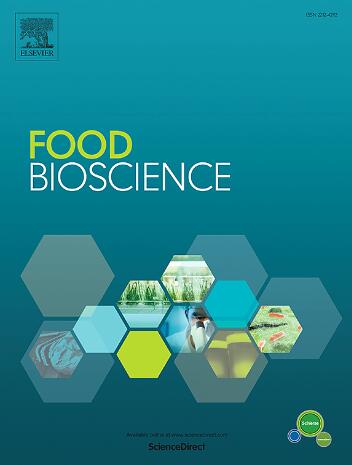Unraveling the mechanism of aroma formation in the maillard reaction of roasted Wuyi rock tea: Focus on furfural, tea pyrrole, and 1-ethyl-1H-Pyrrole
IF 4.8
1区 农林科学
Q1 FOOD SCIENCE & TECHNOLOGY
引用次数: 0
Abstract
The formation mechanisms of key aroma-active compounds in Wuyi rock tea (WRT)—furfural, tea pyrrole, and 1-ethyl-1H-pyrrole, which contribute to its roasted aroma and low sensory thresholds—remain unclear. This study employed the carbon module labeling (CAMOLA) technique to simulate medium-fire roasting conditions (130 °C, 5 h) of WRT, enabling the elucidation of the formation pathways within a theanine-glucose Maillard system. Aroma components were identified using solid-phase microextraction coupled with comprehensive two-dimensional gas chromatography-mass spectrometry. Results showed that the carbon skeletons of furfural and 5-hydroxymethylfurfural were primarily derived from glucose, while the glutamic acid component of theanine also contributed to the formation. The carbon skeleton of pyrrole compounds was entirely supplied by glucose, with the N-ethylamine group originating from the ethylamine moiety of theanine. Epigallocatechin gallate modulated pyrrole formation by promoting the Strecker degradation pathway and altering glucose cleavage patterns. Glucose significantly influenced furfural formation, while theanine played a crucial role in generating tea pyrrole and 1-ethyl-1H-pyrrole. Thus, these compounds can serve as critical indicators for monitoring the roasting process.

揭示武夷岩茶焙烤美拉德反应香气形成机理:重点研究糠醛、茶吡咯和1-乙基- 1h -吡咯
武夷岩茶(WRT)中主要香气活性物质糠醛、茶吡咯和1-乙基- 1h -吡咯的形成机制尚不清楚,它们对其烘烤香气和低感官阈值起着重要作用。本研究采用碳模块标记(CAMOLA)技术模拟了WRT的中火焙烧条件(130°C, 5 h),从而阐明了茶氨酸-葡萄糖美拉德体系中的形成途径。采用固相微萃取-综合二维气相色谱-质谱联用技术鉴定其香气成分。结果表明,糠醛和5-羟甲基糠醛的碳骨架主要来源于葡萄糖,茶氨酸的谷氨酸成分也参与了碳骨架的形成。吡咯化合物的碳骨架完全由葡萄糖提供,其中n -乙胺基来源于茶氨酸的乙胺部分。表没食子儿茶素没食子酸酯通过促进streker降解途径和改变葡萄糖裂解模式来调节吡咯的形成。葡萄糖对糠醛的生成有显著影响,而茶氨酸在茶吡咯和1-乙基- 1h -吡咯的生成中起关键作用。因此,这些化合物可以作为监测焙烧过程的关键指标。
本文章由计算机程序翻译,如有差异,请以英文原文为准。
求助全文
约1分钟内获得全文
求助全文
来源期刊

Food Bioscience
Biochemistry, Genetics and Molecular Biology-Biochemistry
CiteScore
6.40
自引率
5.80%
发文量
671
审稿时长
27 days
期刊介绍:
Food Bioscience is a peer-reviewed journal that aims to provide a forum for recent developments in the field of bio-related food research. The journal focuses on both fundamental and applied research worldwide, with special attention to ethnic and cultural aspects of food bioresearch.
 求助内容:
求助内容: 应助结果提醒方式:
应助结果提醒方式:


